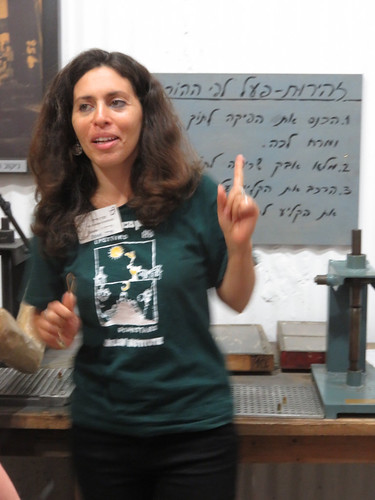Israel 2017–Day 2
Picture Gallery for this entry
We’re staying at the boutique Melody Hotel across the street from a park that fronts the Mediterranean.
After a sumptuous breakfast, our amiable guide, Gabi, ushers the group of 12 Gate 1 travelers under her care to the bus. Six are Russian speakers from New Jersey. Our first stop is to be the Ayalon Institute, an “armaments factory” near the Weizmann Institute of Science and a big high tech park.
We enter a treed compound of tin sheds surrounded by old machinery and watch a movie introducing the facility. During the last years of the British Mandate, the Haganah, or Israeli underground army, was preparing for a war of independence against the local Palestinians and their allies, the surrounding Arab states. In order to placate the Arabs and keep the peace, the British were trying to severely limit immigration of postwar Jewish refugees and prevent the purchase or production of arms.
The Haganah recruited a select group of young people to secretly manufacture bullets at a factory hidden near a British military outpost. It was located underground, 25 feet below the laundry room of a school teaching agricultural skills to kibbutz newcomers.
The young local guide leads us down to it via a spiral staircase that opens under the communal laundry’s washing machine. In thickly accented English, she relates stories of hardship and heroism with an enthusiasm that eventually I cant resist sharing.
Back on the bus Gabi says that the War of Independence’s solidarity is hard to find these days in Israel. Nevertheless, some patriotism in young people still remains due to the draft, which requires 3 years’ military service for men and two for women immediately after high school graduation.
She herself benefited from it, rising to the rank of Captain in the Air Force, and so did her children. That service provides the education, discipline, and sense of identity required by people of that age as well as the military strength needed by a nation surrounded by enemies.
Now I’m drawn in further.
Next stop is the old port city of Jaffa, where we walk around the hilltop offering impressive views of the ocean and of the new city of Tel Aviv.
Jaffa’s buildings and streets have been turned into a tourist park of boutiques and galleries, oppressive in the crowds and heat of midday. We walk down the hill to a funky local market and a cavernous restaurant, where we order Shakshuka, a dish of tomato, eggplant, cheese and fried egg served by a lively young waitress in short shorts.
As opposed to Tel Aviv, which is almost exclusively Jewish, Jaffa has a mixed population Jews, Arabs, and other ethnicities and religions.
The bus takes us on to Tel Aviv’s City Hall plaza and the memorial where Yitzhak Rabin was assassinated in 1995 by a Jewish fundamentalist at a massive rally celebrating the handshake with Yasser Arafat. Gabi tells us that she was there when it happened and is still traumatized by the memory of the tragedy. For many Israelis it was the end of hope that a real peace between Israelis and Palestinians could be achieved.
After a welcome nap, we get ready for the dinner engagement Jan prearranged with her undergraduate friend, Cheryl, now named Shira, and her husband, Baruch, a retired surgeon who grew up in rural Texas. Knowing that they are Haredi makes us apprehensive. She has borne six children to a previous husband and is strictly observant to the extent of wearing a wig. Before getting into their car, we’re told that men sit in front, women in back and that there are no coed handshakes. But despite the religious and cultural gulf, within a few minutes we connect, first on the basis of University affiliation and then through sharing some of our life stories. Shira has brought along her book on the Bible and science and articles she’s written in English for an orthodox newspaper, and they are interested in my conference presentation and Jan’s experience as Mayor.
Baruch drives through horrendous traffic to Bnei Brak, a poor section of the City where streets are packed with men of all ages in sundry variations of the Haredi black and white uniform.
We end up at a Yemeni restaurant attached to a large gas station where they treat us to a simple dinner of grilled chicken and french fries. The atmosphere is loud, exuberant, and friendly among workers and large families. We linger in conversation for three more hours before a bittersweet farewell back at the hotel.









